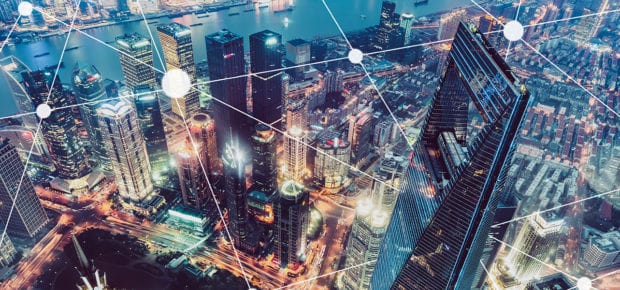October 15, 2018
According to new research published on IEEE Xplore, 70% of the world’s population will likely live in cities by 2050, “resulting in an unprecedented increase in the consumption of existing resources.” And while cities have their environmental advantages, like smaller geographic footprints that impact fewer ecological systems, they still present a number of challenges. For example, major cities’ usage of fossil fuels “constitutes 75% of global energy resource use,” despite occupying only approximately 5% of the planet’s total land mass.
Smart city technologies often come up as having the potential to improve quality of life in urban areas, but there’s also increasing hope that they can make cities more sustainable, too.
Before we get too far, what exactly constitutes a smart city? We asked IEEE Senior Member Shawn Chandler, Chair of the IEEE Internet of Things Smart Cities Working Group, to explain it: “A smart city uses technology and data to align physical, institutional, social and technical elements of the city, assisting public, government and other stakeholders to improve performance of city functions, increase awareness of city resources and advance the well-being of citizens.”
Traffic management, public transit, water and waste management, public safety, electricity and natural gas supply all present challenges with reliability, particularly as the systems age. Many of you reading this are familiar with these problems first-hand. And as cities grow, the demands on this infrastructure increase, as do their importance for city operations.
Legacy city infrastructure is being retrofitted with sensors and Internet of Things (IoT) technologies familiar from consumer devices, like Bluetooth and near-field communication. This generates 24/7 real-time metering data, the analysis of which the researchers are optimistic will “improve city operations, ensure the well-being of citizens and meet the expectations for urban sustainability.”
Let’s take a look at vehicles in urban areas as an illustrative example.
Emissions are a major issue for cities, both in terms of environment and human health. To Chandler, electric vehicles are a clear answer because they’re “demonstrably more efficient than petroleum-based transportation in terms of fuel consumption,” while they also “reduce local air pollution, and overall pollution by transferring the energy production to higher efficiency resources including both renewable and centralized power generation.”
To the researchers looking into sustainability, the effects of electric public transit buses goes beyond emissions: “electric buses can work closely with the electric power infrastructure to minimize the impact of charging batteries at peak load hours.” Additionally, with proper coordination, these vehicles can help with frequency regulation for the grid when not in service.
That gives you an initial sense of how these vehicles are part of the larger smart city infrastructure. An even more direct case is autonomous vehicles, whose efficient operation “require a seamless integration of automobiles, sensors, actuators, telecommunications and analytics with legacy transportation infrastructures,” according to the researchers.
This is obviously no small task. To Chandler, exchanging data between these entities “will require massive communications capacities that [5G and 6G communications] will be able to deliver reliably.” There are Transmitter articles on the Internet of Vehicles and the role of 5G in the IoT if you want to read more about them.
Ultimately, as these technologies grow more advanced, the number of cars in cities should decrease. Says Chandler, “autonomous vehicles have the potential to change the ‘ownership’ model that has been accepted and culturally ingrained planet-wide over the last 100 years.” For many people, owning a car is one of their biggest expenses, yet “they are sitting idle for 90% of the time or more.” This decrease would be good news for environmental sustainability.
Free access to this research from IEEE Electrification Magazine (IEEE Power & Energy Society) is provided by IEEE Technical Community Spotlight, a newsletter that shares the latest breaking news from IEEE societies and communities. You can find the latest issue here. Read the full paper before free access ends on December 10th.






 The Impact of Technology in 2025
The Impact of Technology in 2025 Quantum and AI: Safeguards or Threats to Cybersecurity?
Quantum and AI: Safeguards or Threats to Cybersecurity? Why AI Can't Live Without Us
Why AI Can't Live Without Us Bits, Bytes, Buildings and Bridges: Digital-Driven Infrastructure
Bits, Bytes, Buildings and Bridges: Digital-Driven Infrastructure Impact of Technology in 2024
Impact of Technology in 2024 Emerging AI Cybersecurity Challenges and Solutions
Emerging AI Cybersecurity Challenges and Solutions The Skies are Unlimited
The Skies are Unlimited Smart Cities 2030: How Tech is Reshaping Urbanscapes
Smart Cities 2030: How Tech is Reshaping Urbanscapes Impact of Technology 2023
Impact of Technology 2023 Cybersecurity for Life-Changing Innovations
Cybersecurity for Life-Changing Innovations Smarter Wearables Healthier Life
Smarter Wearables Healthier Life Infrastructure In Motion
Infrastructure In Motion The Impact of Tech in 2022 and Beyond
The Impact of Tech in 2022 and Beyond Cybersecurity, Technology and Protecting Our World
Cybersecurity, Technology and Protecting Our World How Technology Helps us Understand Our Health and Wellness
How Technology Helps us Understand Our Health and Wellness The Resilience of Humanity
The Resilience of Humanity Harnessing and Sustaining our Natural Resources
Harnessing and Sustaining our Natural Resources Creating Healthy Spaces Through Technology
Creating Healthy Spaces Through Technology Exceptional Infrastructure Challenges, Technology and Humanity
Exceptional Infrastructure Challenges, Technology and Humanity The Global Impact of IEEE's 802 Standards
The Global Impact of IEEE's 802 Standards Scenes of our Cyber Lives: The Security Threats and Technology Solutions Protecting Us
Scenes of our Cyber Lives: The Security Threats and Technology Solutions Protecting Us How Millennial Parents are Embracing Health and Wellness Technologies for Their Generation Alpha Kids
How Millennial Parents are Embracing Health and Wellness Technologies for Their Generation Alpha Kids Space Exploration, Technology and Our Lives
Space Exploration, Technology and Our Lives Global Innovation and the Environment
Global Innovation and the Environment How Technology, Privacy and Security are Changing Each Other (And Us)
How Technology, Privacy and Security are Changing Each Other (And Us) Find us in booth 31506, LVCC South Hall 3 and experience the Technology Moon Walk
Find us in booth 31506, LVCC South Hall 3 and experience the Technology Moon Walk Virtual and Mixed Reality
Virtual and Mixed Reality How Robots are Improving our Health
How Robots are Improving our Health IEEE Experts and the Robots They are Teaching
IEEE Experts and the Robots They are Teaching See how millennial parents around the world see AI impacting the lives of their tech-infused offspring
See how millennial parents around the world see AI impacting the lives of their tech-infused offspring Take the journey from farm to table and learn how IoT will help us reach the rising demand for food production
Take the journey from farm to table and learn how IoT will help us reach the rising demand for food production Watch technical experts discuss the latest cyber threats
Watch technical experts discuss the latest cyber threats Explore how researchers, teachers, explorers, healthcare and medical professionals use immersive technologies
Explore how researchers, teachers, explorers, healthcare and medical professionals use immersive technologies Follow the timeline to see how Generation AI will be impacted by technology
Follow the timeline to see how Generation AI will be impacted by technology Learn how your IoT data can be used by experiencing a day in a connected life
Learn how your IoT data can be used by experiencing a day in a connected life Listen to technical experts discuss the biggest security threats today
Listen to technical experts discuss the biggest security threats today See how tech has influenced and evolved with the Games
See how tech has influenced and evolved with the Games Enter our virtual home to explore the IoT (Internet of Things) technologies
Enter our virtual home to explore the IoT (Internet of Things) technologies Explore an interactive map showcasing exciting innovations in robotics
Explore an interactive map showcasing exciting innovations in robotics Interactively explore A.I. in recent Hollywood movies
Interactively explore A.I. in recent Hollywood movies Get immersed in technologies that will improve patients' lives
Get immersed in technologies that will improve patients' lives